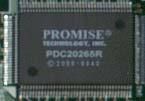Only the Best: 9 Athlon Motherboards With The AMD 760 Chipset
Features
published
IDE RAID Advancing
Additional IDE controllers with RAID functionality are gaining popularity. Unlike SCSI, RAID devices do not boost costs but still provide a great extra value. There are three IDE RAID chips available now: Highpoint's HPT370A, Promise FastTrak100 Lite (PDC20265) and AMI MG80649. Integrated onto a motherboard, they do not require a PCI slot and offer two additional IDE ports for two devices each.


All chips support five different modes:
- Standard IDE Controller
You may attach up to 4 additional devices (2 at each port)- Disk Spanning
The controller chip creates one single volume out of all hard drives attached. The capacity of small hard drives can be combined by this feature- Striping (RAID 0)
That's the most interesting mode for many users: After attaching two or four IDE hard drives to the RAID controller, it will create one volume out of them. Data is written and read on alternating drives, resulting in a drastic increased data transfer rate. Using drives of different capacities is not recommended, though the array would work.- Mirroring (RAID 1)
This feature is very useful for data safety. It requires two or four hard drives. Data is always written simultaneously onto two drives. If one of those drives fails, you will still have the latest data backed up on the second drive. That will only work with drives of the same capacity.- Mirroring + Striping (RAID 0+1)
This mode requires four drives. Two of them will be striped while this will be mirrored onto the remaining two disks. Only works with drives that have the same capacity.
Stay on the Cutting Edge
Join the experts who read Tom's Hardware for the inside track on enthusiast PC tech news — and have for over 25 years. We'll send breaking news and in-depth reviews of CPUs, GPUs, AI, maker hardware and more straight to your inbox.
More about chipsets
No comments yet
Comment from the forums
Most Popular

